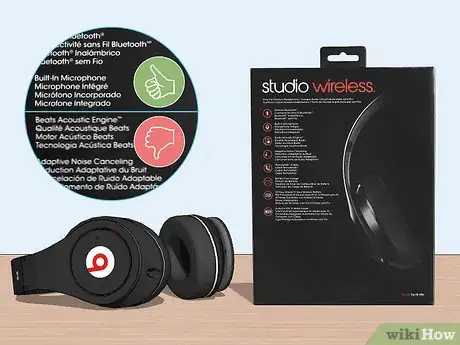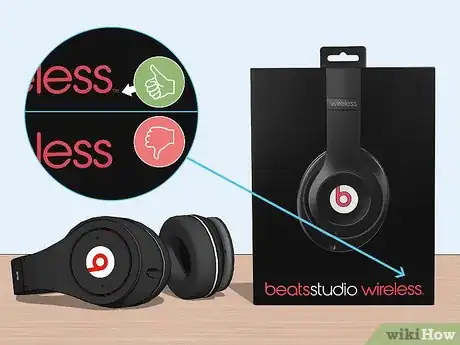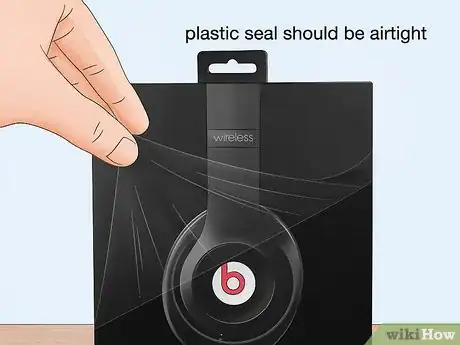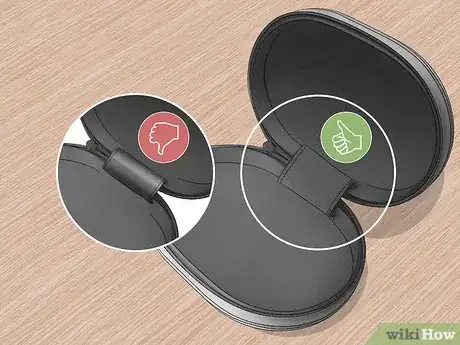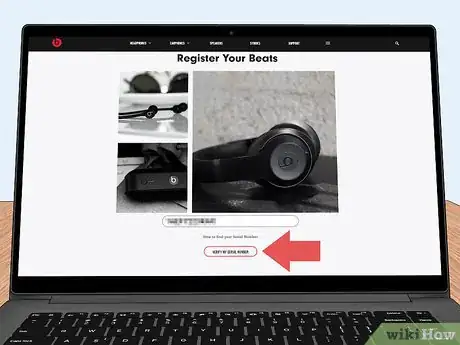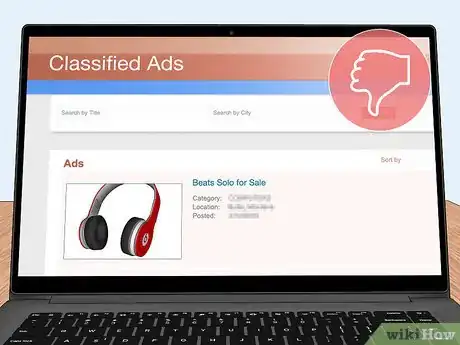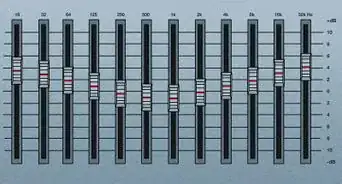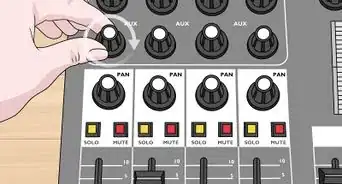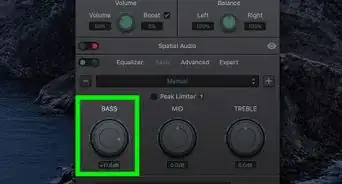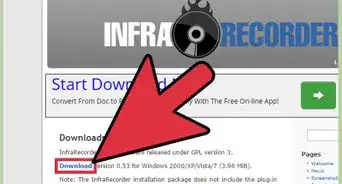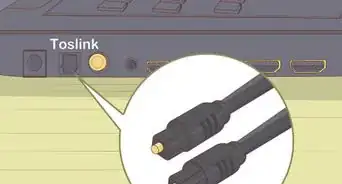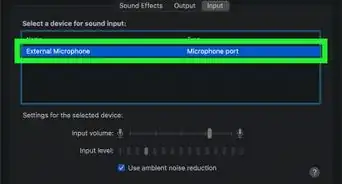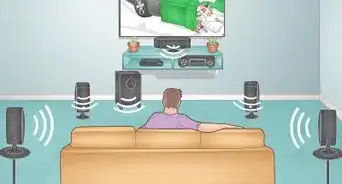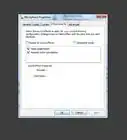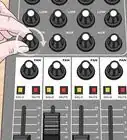This article was co-authored by wikiHow staff writer, Eric McClure. Eric McClure is an editing fellow at wikiHow where he has been editing, researching, and creating content since 2019. A former educator and poet, his work has appeared in Carcinogenic Poetry, Shot Glass Journal, Prairie Margins, and The Rusty Nail. His digital chapbook, The Internet, was also published in TL;DR Magazine. He was the winner of the Paul Carroll award for outstanding achievement in creative writing in 2014, and he was a featured reader at the Poetry Foundation’s Open Door Reading Series in 2015. Eric holds a BA in English from the University of Illinois at Chicago, and an MEd in secondary education from DePaul University.
This article has been viewed 294,482 times.
Learn more...
Beats are a trendy brand of headphones that fetch a high-end price tag at the store. As a result of their popularity, brand-name recognition, and price, they’re often counterfeited in an attempt to rip off unsuspecting buyers. To spot a fake pair of Beats headphones, start with the external packaging. Look at the printing of the letters, the trademark logos, and the quality of the plastic wrap. Once a box is opened, inspect the inside of the right ear to see if there’s a serial number. Go online to see if the serial number is valid or already in-use. To avoid getting scammed, only buy expensive electronics from licensed retailers and remember: if a deal sounds too good to be true, it probably is.
Things You Should Know
- Check the packaging for clean typeface, a "Studio" or "Solo" trademark logo, and an airtight plastic seal. Also make sure that the padding on the case's inside crease matches the padding on the rest of the case.
- Make sure the serial number is on the right ear. If it is printed on the left ear, your headphones are definitely fake.
- Try registering your headphones. Go to https://www.beatsbydre.com/register and enter the serial number. If the serial number is not found, it's possible that your headphones are fake.
Steps
Inspecting the Packaging
-
1Look at the typeface on the box to see if it’s blurry or clean. Often, you can determine whether Beats are fake or not simply by looking carefully at the words on the box. Real Beats have a strong contrast between the letters on the outside of the package and the minimalistic background. If the letters are blurry, faded, or look like they were printed on paper and glued to the box, you may have a box of fake Beats.[1]
- Every model and version of Beats has slightly different packaging. This can make it hard to identify certain fakes.
-
2Check the big “Studio” or “Solo” for a trademark logo on the bottom right. The Studio and Solo model of Beats headphones are the 2 higher-end models that are often faked. Both of these headphones have the model name printed in large letters on the side and back of the box. If the Studio or Solo printed on the back doesn’t have a trademark logo on the bottom right side, it may be a fake pair.[2]
- The trademark logo is simply the letters TM, printed in a smaller font.
- Some versions of the headphones don’t have the trademark logo on the front or back, but on the manual that comes with the headphones.
- The EP lineup of headphones is not trademarked, so it won’t have a trademark logo. They are the cheaper lineup of headphones though, so they’re rarely counterfeited.
Advertisement -
3Compare the photo of the headphones on the box to an authentic package. If the packaging is fake, the box may have been digitally edited. To look authentic, the counterfeiter likely had to replace the picture of the headphones on the box. See if the headphone on the box matches the headphones on the Beats official website. Specifically, compare the highlights created by the light on the official packaging to the highlights on the box you’re inspecting. If the photo is off, the packaging is edited and you almost certainly have a fake pair.[3]
- On the Studio and Solo boxes, the highlights created by the lights are on the top of the ear on both the left and the right.
-
4Investigate the plastic seal to see if it’s airtight around the packaging. The box that the Beats come in should be firmly sealed in a plastic cover. If the plastic isn’t airtight, the Beats may have been tampered with. If you’re considering buying a brand new pair, don’t go through with the purchase if the plastic is missing, partially removed, or damaged.[4]
- It is really hard to reseal fake headphones in the plastic casing that real Beats come in. This is because most counterfeiters don’t have access to the binding machines needed to seal something in plastic.
-
5Look at the seam on the carrying case to see if it’s shiny or thin. Take the carrying case out and unzip it. Unfold the carrying case and inspect the zipper-less section where the 2 halves of the case fold over. If the padding on the inside of the crease is identical to the rest of the case’s padding, the beats are probably real. If the fabric is shinier or thinner than the rest of the case, the headphones may be fake.[5]
- This is an exceptionally common element amongst counterfeit headphones. Many fake headphone manufacturers put all of the effort into making the headphones look right that they forget about things like the carrying case.
- Counterfeiters will often take 2 broken halves of the carrying case and glue or knit them together to refit a carrying case. This makes the crease for a fake pair look different than a real one.
- On a real pair, the padding on the crease will be identical to the rest of the case.
Checking the Serial Number and Software
-
1Find which ear the serial number is printed on for a simple test. With the headphones in both hands, look at the case around each ear cushion. You will find an “L” and “R” which indicate which ear is the left side and which ear is the right side. Pull your headphones out to extend the headband and make it taller. Look on the inside of the exposed plastic that comes up to raise the headband to find your serial number. If the number is on the left ear, the headphones are absolutely fake.[6]
- Beats never prints the serial number on the left ear. However, just because the number is on the right doesn’t mean that the headphones are automatically real.
- If your serial number is on the right, try registering it to see if the number is valid.
-
2Register your Beats online to see if the serial number is valid. Go to https://www.beatsbydre.com/register and wait for the registration screen to pop up. Enter the serial number listed on the right side of your headphones. Press “verify my serial number.” If a screen pops up that says, “We’re Sorry,” your serial number is invalid. This is a possible sign that you’ve got a pair of counterfeit headphones on hand.[7]
- If you bought used headphones, it may simply have already been verified. The seller should still be able to show you the verification paperwork or their online profile to prove it though.
-
3Plug in your beats to the computer while visiting the upgrade page to run a test. Go online to the Beats update page where owners of Beats headphones can update drivers and patch security issues. The site installs updates through your computer by plugging a USB cable into any port and connecting it to your headphones. If your headphones are fake, you’ll get an error message when you plug them in to update them. Visit http://your.beatsbydre.com/#/?locale=en-US to open the update page.[8]
- You aren’t really putting your computer at risk by plugging in fake headphones. The odds that they’re going to be infected with malware or viruses are really low.
Taking Preventative Measures to Avoid Fakes
-
1Buy from authorized retailers to avoid counterfeits. If you buy headphones from a personal seller on Craigslist who doesn’t have the receipt or warranty information, you’re highly likely to purchase fake headphones. If you buy from a reputable seller at a brick-and-mortar store, you’re less likely to get ripped off by a pair of fake headphones.[9]
- Amazon, Best Buy, Micro Center, Nike, and Target are all examples of authorized retailers. You can find the complete list of legitimate retailers online at https://www.beatsbydre.com/company/authorized-retailers.
-
2Avoid prices that seem too good to be true. There’s no real reason that someone would price $250 headphones at $50 unless they’re damaged or fake. If it sounds like an unbelievable deal, don’t believe it. Unless there’s a giant promotion going on at an authorized retailer or you’re buying them during a Black Friday event, the odds are high that something will be seriously wrong with the headphones.[10]
-
3Dismiss classified ads or auctions where the paperwork is missing. While it’s not impossible to get a good deal on some headphones by buying a used pair from another individual, be wary of any offers that don’t include the warranty paperwork. If they don’t have the warranty paperwork and you really want to know they’re real, try registering the serial number before handing the money over. It’s impossible to fake a legitimate serial number.[11]
- If they’ve already registered the headphones, they should have the registration paperwork or a link to a personalized profile with the headphones listed.
Community Q&A
Did you know you can get answers researched by wikiHow Staff?
Unlock staff-researched answers by supporting wikiHow
-
QuestionWho's face is on the Beats box to tell if they're knockoffs?
 wikiHow Staff EditorThis answer was written by one of our trained team of researchers who validated it for accuracy and comprehensiveness.
wikiHow Staff EditorThis answer was written by one of our trained team of researchers who validated it for accuracy and comprehensiveness.
Staff Answer wikiHow Staff EditorStaff Answer
wikiHow Staff EditorStaff Answer -
QuestionShould it say "Beats By Dre" or "Beats by Dr. Dre"?
 BardCommunity AnswerOn the official Beats website it says "Beats By Dre" and on BestBuy's website and Apple's website it says "Beats By Dr. Dre," I wouldn't buy Beats if the place I was buying them from wasn't a well known store, too many fakes and scams.
BardCommunity AnswerOn the official Beats website it says "Beats By Dre" and on BestBuy's website and Apple's website it says "Beats By Dr. Dre," I wouldn't buy Beats if the place I was buying them from wasn't a well known store, too many fakes and scams. -
QuestionI've seen some that say "Beats By Dre" and some that just say "Beats." What's the difference?
 Community AnswerThe one that says "Beats" might be counterfeit. It usually says "Beats By Dre" on the headphones.
Community AnswerThe one that says "Beats" might be counterfeit. It usually says "Beats By Dre" on the headphones.
References
- ↑ http://www.detectafake.com/viewProduct/?269578
- ↑ http://www.detectafake.com/viewProduct/?269578
- ↑ http://www.detectafake.com/viewProduct/?269578
- ↑ https://www.beatsbydre.com/support/safe-buying
- ↑ https://youtu.be/LhKvwrnUBZA?t=107
- ↑ https://youtu.be/LhKvwrnUBZA?t=140
- ↑ https://www.beatsbydre.com/register
- ↑ http://your.beatsbydre.com/#/download?locale=en-US
- ↑ https://www.beatsbydre.com/support/safe-buying
